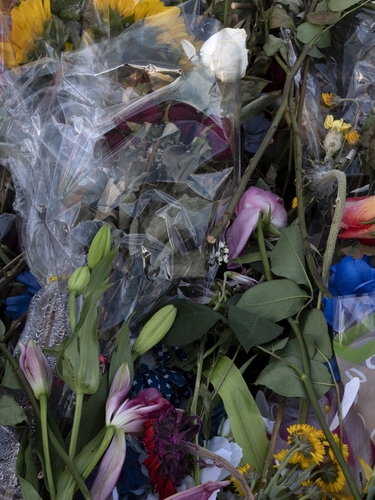BRATTLEBORO — The Brattleboro Museum & Art Center (BMAC) exhibit “All Flowers Keep the Light” - on view through Sunday, June 13 - was postponed for nearly a year because of the pandemic.
Initially conceived as an exploration of artwork harnessing the beauty and symbolic potential of flowers to mark personal loss, it was expanded to include work commemorating communal and societal ruptures.
Curated by BMAC Chief Curator Mara Williams, “All Flowers Keep the Light” draws its title from a line in a Theodore Roethke poem: “Deep in their roots, all flowers keep the light.” It includes work by Miles Chapin, Clare Elliott, Amy Jenkins, Colleen Kiely, Cathy Osman, Anna Schuleit Haber, and John Willis (in collaboration with poet Robin Behn and musician Matan Rubinstein).
Highlights
“Flowers have been seen for millennia and across cultures as spiritual and emotional touchstones,” said Williams in a news release. “Art made at a time of crisis, loss, and mourning can reassure, ease despair, and open the possibility of hope.”
• Miles Chapin responded to the pandemic by sculpting a stylized blossom thrusting its smooth surface up through a tower of rough stone. The abstract flower blooms from a split in the massive rock and appears to float weightlessly above it.
“Chapin has given us a monument to hope and beauty just when we need it,” Williams said.
• Clare Elliott's portrait installation memorializes the life and work of her godmother, Lori S. Goodman, a noted Washington, D.C.-area dancer, teacher, and choreographer. To create her collaborative, communal work, Elliott invited “Miss Goodman's Girls” to participate as both subjects and creators.
“The central figure in the collaged portrait installation is Goodman herself - surrounded by roses, mid-movement, her body extended, arm reaching skyward,” Williams said. “She is joined by the women she taught, each one strong, self-possessed, full of grace.”
• Amy Jenkins portrays the life cycle of a tulip bouquet via two-channel video created from more than 200,000 photographs taken over 36 days. One channel is a forward loop, while the other plays in reverse.
“On one monitor the flowers lift toward the sky with vitality; on the other, they diminish as they collapse on themselves,” Williams said. “As in the Buddhist concept of samsÄra, the budding, opening, then petal-dropping and resurrection of the tulips loop perpetually.”
• Colleen Kiely gathered the floral tributes left after her mother's funeral and brought them back to her studio. As the bouquets withered, she repeatedly refashioned them into new arrangements, which she then captured in a suite of large drawings.
“Creating the series became a pathway to healing for Kiely, each new arrangement and drawing testifying to a daughter's love,” Williams said.
• During the spring of 2020, Cathy Osman, a longtime member of the Marlboro College art faculty, completed dozens of flower images that combine printmaking with overpainting. The early pieces focus on blossoms articulated with delicate gestures, while the later ones feature increasingly layered surfaces, intensified mark making, and a deeper palette.
“These works form an enduring record of how Osman kept her faith in art and life during this trying time,” Williams said.
• Anna Schuleit Haber placed 28,000 potted plants and 5,000 square feet of live sod in the abandoned Massachusetts Mental Health Center in 2003 to mark the facility's closing. Corridors, offices, and even the swimming pool were flooded with scent and color. A film and large-format photographs document the lush, living plants alongside decaying rooms, dusty furniture, and detritus.
A graduate of Northfield Mount Hermon School, Schuleit Haber studied painting at the Rhode Island School of Design and was a fellow at the Radcliffe Institute for Advanced Study at Harvard University. She was named a MacArthur Fellow for work that has “conceptual clarity, compassion, and beauty.”
• Former Marlboro College faculty member John Willis focused his lens on the profusion of floral tributes left in the El Paso Walmart parking lot, where 49 people were gunned down on Aug. 3, 2019; 23 of them died.
Poet Robin Behn and composer Matan Rubinstein joined Willis in creating a multimedia “Requiem for the Innocent” consisting of 23 segments, each one a combination of photograph, poem, and musical score.
“We are tired of hearing the stories of guns being used against groups of random victims, too often for how they look, speak, worship, identify, or any such rationalization,” Willis wrote in a statement on his website about the project. “Diversity in the world is something to celebrate, not fear or hate.”
Events
• A public celebration of “All Flowers Keep the Light” and BMAC's other spring exhibits will take place at BMAC on Saturday, May 15, at 5:30 p.m.
• Williams will lead a virtual tour of “All Flowers Keep the Light” and a discussion with many of the artists on Tuesday, June 1, at 7:30 p.m., via Zoom. Register in advance at brattleboromuseum.org.
• “All Flowers Keep the Light” is part of “2020 Vision: Reflecting on a World-Changing Year,” a statewide initiative of the Vermont Curators Group. BMAC is one of 50 museums and galleries participating in the program. For more information, visit vermontcuratorsgroup.com.
